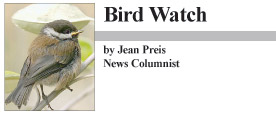New Song
 This week, we have been hearing a new bird song in our neighborhood, a pretty whistle, ending in something that sounds to me like a descending chew-chew-chew-chew. It sounded familiar, and after hearing the song for a few days I wondered it the singer might be a cardinal. Several pairs of cardinals live in town, but since they almost never venture out this way we rarely get to hear them sing.
This week, we have been hearing a new bird song in our neighborhood, a pretty whistle, ending in something that sounds to me like a descending chew-chew-chew-chew. It sounded familiar, and after hearing the song for a few days I wondered it the singer might be a cardinal. Several pairs of cardinals live in town, but since they almost never venture out this way we rarely get to hear them sing.
In order to get more information, I went to the website for Cornell Lab of Ornithology’s Macaulay Library of Natural Sounds (macaulaylibrary.org) and typed “Northern Cardinal†into the Search window. To my surprise there were 504 recordings of northern cardinal songs and calls that had been made in the field over a period of more than 50 years, in places as far apart as Hawaii, Central America, Canada, South Carolina, and Wisconsin. I clicked on a song from New York, and listened to a pretty whistle, followed by what sounded to me like a descending chew-chew-chew-chew. It sounded exactly like the bird in our neighborhood.
The cardinal’s song took me back years, to a time when a friend who lived across the lake invited me to visit a family of cardinals who were nesting near her home. In her front yard, she escorted me to a large shrub, where we stood very quietly as she pointed out the nest deep within the dense foliage. The female cardinal, a lovely blend of greens, olive, gray, buff, and red, was on the nest incubating the eggs while her mate, bright red with a crest and a thick red bill, stood guard in a nearby tree. We had tried to approach quietly, but unfortunately our arrival disturbed her and she left the nest. Inside were four mottled eggs, about an inch long. Like most of the perching birds, cardinals build a cup-shaped nest, open on the top and well hidden by foliage. Twigs form the outer structure of the nest, with layers of grasses inside to give it shape and softness. The inside, where the eggs are laid, is lined with soft plant fibers. While building, the bird gets in the nest and presses it into shape with her breast and belly to make sure it fits.
It takes a female bird about 24 hours to produce an egg, according to Roger F. Pasquier, author of Watching Birds. The newly fertilized egg is first surrounded by yolk, and then covered by the “white.†The shell goes on last, along with various pigments to give the shell its color and markings. Mottled markings on the cardinal’s eggs help camouflage them, as do the shadows cast by surrounding branches. Producing the shell is the longest step, and takes 18 to 20 hours. In a cup-shaped nest where there is little danger that the eggs will roll away, eggs are fairly round. Some species of birds, who nest in dangerous places such as cliffs, produce long narrow eggs, pointed at one end so they will roll in a circle and not roll off the nest.
We did not know exactly how old these eggs were, but we had read that female cardinals incubate them for 12 or 13 days. After the chicks hatch, both parents feed them for another nine or ten days until the chicks are old enough to fly. It’s a busy time for cardinal parents, who have to catch enough insects to feed themselves and their growing family. Once the youngsters are out of the nest, the male parent sometimes feeds the young by himself, freeing his mate to lay more eggs and incubate a second brood. It’s impressive what a couple can accomplish when they work together cooperatively. We worried about disturbing the cardinals so kept our visit short, and as soon as we returned to the house the female returned to her nest to continue caring for her eggs.
As far as we know, cardinals have not yet nested in our neighborhood. The cardinal whom we have heard singing this week may be one of the town cardinals, just visiting for a few days, or he might have a nest hidden nearby. Either way, he and his cheerful song are most welcome here.
Jean Preis is a resident of Bridgton.

